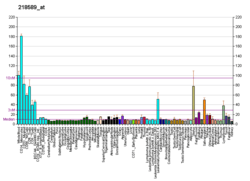LPAR6
Lysophosphatidic acid receptor 6, also known as LPA6, P2RY5 and GPR87, is a protein that in humans is encoded by the LPAR6 gene.[5][6][7][8] LPA6 is a G protein-coupled receptor that binds the lipid signaling molecule lysophosphatidic acid (LPA).[9][10]
The protein encoded by this gene belongs to the family of G-protein coupled receptors, that are preferentially activated by adenosine and uridine nucleotides. This gene aligns with an internal intron of the retinoblastoma susceptibility gene in the reverse orientation.[8]
Role in hair growth/loss
In February 2008, researchers at the University of Bonn announced they have found the genetic basis of two distinct forms of inherited hair loss, opening a broad path to treatments for baldness. They found that mutations in the gene P2RY5 causes a rare, inherited form of hair loss called hypotrichosis simplex. It is the first receptor in humans known to play a role in hair growth. The fact that any receptor plays a specific role in hair growth was previously unknown to scientists, and with this new knowledge a focus on finding more of these genes may be able to lead to therapies for many different types of hair loss.[9]
In 2013, it was found that mutations in LPAR6 give rise to the Cornish Rex cat breed, which has a form of ectodermal dysplasia characterised by short woolly hair which is susceptible to loss.[11]
See also
References
- GRCh38: Ensembl release 89: ENSG00000139679 - Ensembl, May 2017
- GRCm38: Ensembl release 89: ENSMUSG00000033446 - Ensembl, May 2017
- "Human PubMed Reference:". National Center for Biotechnology Information, U.S. National Library of Medicine.
- "Mouse PubMed Reference:". National Center for Biotechnology Information, U.S. National Library of Medicine.
- Adrian K, Bernhard MK, Breitinger HG, Ogilvie A (Sep 2000). "Expression of purinergic receptors (ionotropic P2X1-7 and metabotropic P2Y1-11) during myeloid differentiation of HL60 cells". Biochim Biophys Acta. 1492 (1): 127–38. doi:10.1016/S0167-4781(00)00094-4. PMID 11004484.
- Ralevic V, Burnstock G (Nov 1998). "Receptors for purines and pyrimidines". Pharmacol Rev. 50 (3): 413–92. PMID 9755289.
- Yanagida K, Masago K, Nakanishi H, Kihara Y, Hamano F, Tajima Y, Taguchi R, Shimizu T, Ishii S (Jun 2009). "Identification and characterization of a novel lysophosphatidic acid receptor, p2y5/LPA6". J Biol Chem. 284 (26): 17731–41. doi:10.1074/jbc.M808506200. PMC 2719412. PMID 19386608.
- "Entrez Gene: P2RY5 purinergic receptor P2Y, G-protein coupled, 5".
- Pasternack SM, von Kügelgen I, Aboud KA, Lee YA, Rüschendorf F, Voss K, Hillmer AM, Molderings GJ, Franz T, Ramirez A, Nürnberg P, Nöthen MM, Betz RC (March 2008). "G protein-coupled receptor P2Y5 and its ligand LPA are involved in maintenance of human hair growth". Nat. Genet. 40 (3): 329–34. doi:10.1038/ng.84. PMID 18297070.
- Choi JW, Herr DR, Noguchi K, Yung YC, Lee CW, Mutoh T, Lin ME, Teo ST, Park KE, Mosley AN, Chun J (January 2010). "LPA Receptors: Subtypes and Biological Actions". Annual Review of Pharmacology and Toxicology. 50 (1): 157–186. doi:10.1146/annurev.pharmtox.010909.105753. PMID 20055701.
- Gandolfi, Barbara; Alhaddad, Hasan; Affolter, Verena K.; Brockman, Jeffrey; Haggstrom, Jens; Joslin, Shannon E. K.; Koehne, Amanda L.; Mullikin, James C.; Outerbridge, Catherine A. (2013-06-27). "To the Root of the Curl: A Signature of a Recent Selective Sweep Identifies a Mutation That Defines the Cornish Rex Cat Breed". PLoS ONE. 8 (6): e67105. Bibcode:2013PLoSO...867105G. doi:10.1371/journal.pone.0067105. ISSN 1932-6203. PMC 3694948. PMID 23826204.
Further reading
- Toguchida J, McGee TL, Paterson JC, et al. (1993). "Complete genomic sequence of the human retinoblastoma susceptibility gene". Genomics. 17 (3): 535–43. doi:10.1006/geno.1993.1368. PMID 7902321.
- Maruyama K, Sugano S (1994). "Oligo-capping: a simple method to replace the cap structure of eukaryotic mRNAs with oligoribonucleotides". Gene. 138 (1–2): 171–4. doi:10.1016/0378-1119(94)90802-8. PMID 8125298.
- Herzog H, Darby K, Hort YJ, Shine J (1997). "Intron 17 of the human retinoblastoma susceptibility gene encodes an actively transcribed G protein-coupled receptor gene". Genome Res. 6 (9): 858–61. doi:10.1101/gr.6.9.858. PMID 8889552.
- Li Q, Schachter JB, Harden TK, Nicholas RA (1997). "The 6H1 orphan receptor, claimed to be the p2y5 receptor, does not mediate nucleotide-promoted second messenger responses". Biochem. Biophys. Res. Commun. 236 (2): 455–60. doi:10.1006/bbrc.1997.6984. PMID 9240460.
- Suzuki Y, Yoshitomo-Nakagawa K, Maruyama K, et al. (1997). "Construction and characterization of a full length-enriched and a 5'-end-enriched cDNA library". Gene. 200 (1–2): 149–56. doi:10.1016/S0378-1119(97)00411-3. PMID 9373149.
- Strausberg RL, Feingold EA, Grouse LH, et al. (2003). "Generation and initial analysis of more than 15,000 full-length human and mouse cDNA sequences". Proc. Natl. Acad. Sci. U.S.A. 99 (26): 16899–903. Bibcode:2002PNAS...9916899M. doi:10.1073/pnas.242603899. PMC 139241. PMID 12477932.
- Ota T, Suzuki Y, Nishikawa T, et al. (2004). "Complete sequencing and characterization of 21,243 full-length human cDNAs". Nat. Genet. 36 (1): 40–5. doi:10.1038/ng1285. PMID 14702039.
- Dunham A, Matthews LH, Burton J, et al. (2004). "The DNA sequence and analysis of human chromosome 13". Nature. 428 (6982): 522–8. Bibcode:2004Natur.428..522D. doi:10.1038/nature02379. PMC 2665288. PMID 15057823.
- Gerhard DS, Wagner L, Feingold EA, et al. (2004). "The status, quality, and expansion of the NIH full-length cDNA project: the Mammalian Gene Collection (MGC)". Genome Res. 14 (10B): 2121–7. doi:10.1101/gr.2596504. PMC 528928. PMID 15489334.
- Ihara H, Hirukawa K, Goto S, Togari A (2005). "ATP-stimulated interleukin-6 synthesis through P2Y receptors on human osteoblasts". Biochem. Biophys. Res. Commun. 326 (2): 329–34. doi:10.1016/j.bbrc.2004.11.037. PMID 15582581.
External links
- LPAR6 human gene location in the UCSC Genome Browser.
- LPAR6 human gene details in the UCSC Genome Browser.
This article incorporates text from the United States National Library of Medicine, which is in the public domain.




